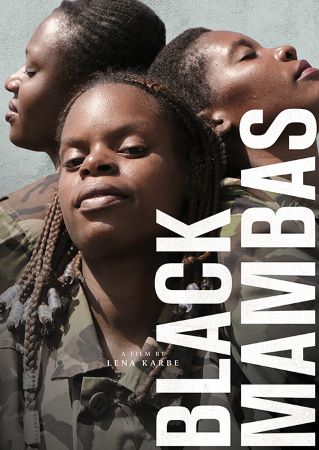
Black Mambas 2022
Distributed by Docuseek2
Produced by Lena Karbe, Ramadan Suleman, and Jan Vasak
Directed by Lena Karbe
Streaming, 81 mins
College - General Adult
Colonial legacy; Female empowerment; Gender Norms; Wildlife conservation
Date Entered: 12/15/2023
Reviewed by Innocent A. Awasom, Associate Librarian (STEM), Texas Tech University Libraries, Lubbock, TXThe Kruger National Park, a thousand acres private wildlife reserve in South Africa, was established in 1920 as a symbol of white unity between the British and the Dutch. It is named after President Paul Kruger, who persuaded the Transvaal parliament to establish a protected area for wildlife in the Lowveld region that spreads across open woodland with long grass making it the natural habitat for game. The Big Five animals namely the lion, elephant, buffalo, rhinoceros, and leopard as well as the cheetah, giraffe, hippopotamus, oryx, kudu, and eland survive only in or near such protected areas as poaching intensified in the last decade due to increased value for rhino horn, tusks and other wildlife parts in the black market. The need to protect the wildlife, especially rhinos from poachers following on the heels of the success of social media and wildlife documentaries, led to the formation of the Black Mambas – the subject of this exciting film.
Black Mambas is a film about an all-female anti-poaching unit dressed in the admired and revered military fatigues or camouflage. That uniform serves as the major recruitment attractant to the many young ladies in the surrounding Black community with a high unemployment rate. The Black Mambas/Rangers, operate in the Kruger National Park which is one of the largest game reserves in South Africa. This film explores the intersection between gender norms, wildlife conservation, race, and the relics of apartheid three decades after independence.
This documentary follows the life of three ladies of the Black Mamba squad from their homes to work and into the community documenting their joys, trials, struggles, dreams and aspirations for over a period of one year. The film begins with a poignant quote from one of the poachers who is not identified as his back is turned to the camera. He states, “If you have a dog as a pet and you don’t feed it, the moment someone else gives it food, you will no longer own it”; and “If someone with money shows up while you are starving and tells you there is money for poaching over there, you will go without blinking.” The above statements bring to sharp focus the challenges faced by the poor Black community living in the environs of the natural game reserve which is a popular tourist attraction that impacts the economy, with very little trickling down to improve the lives of the locals whose only other job opportunity lies in the deadly mining industry that can only employ just as much.
We follow the ladies at a boot camp where they are seen training in their uniforms as well as patrolling the daily routine seven km long concourse inside the reserve looking for traces of poachers, holes in the fence and other snares set up by poachers. Naledi the first of three ladies interviewed, talks of the Black Mamba as being her dream job as it’s about female empowerment and financial independence, thus not following the path of their “mothers” who are heads of households and work in deplorable conditions in the mines. Nkateko on the other hand, looks at things from a socioeconomic perspective and laments about the fate of her “fathers and brothers” with rudimentary tools, who kill for food vis-a-vis "trophy hunters", asserting that poaching is a result of limited job opportunities in the community, exacerbated by the COVID-19 pandemic. She reflects on her uncertain future as a Black Mamba and dreams of becoming a tour guide but with limited resources how can she achieve that dream? They live from paycheck to paycheck given the heavy family responsibilities that they shoulder. Qolile on the other hand is more carefree and lives with her unemployed boyfriend and two kids and content to be where she is. The ladies face challenges not only with their jobs but also with social connections such as being away from home for long periods of time and that affects other social relationships such as missing out on regular girl talks and catching up on the soccer field and other meeting grounds. Interviews with Craig Spencer, the founder of Black Mambas as well as one of the trainers or drill instructors Johan are quite revealing about the anti- poaching community organizers.
Technically the quality of the pictures, sound and music are very appealing and makes for great viewing with beautiful sunrises and sunsets, great savannah landscapes and beautiful exotic animals. The dialogues, sound effects and music are such a great blend as they bring suspense to life when needed. The film raises more questions than answers for who are the real poachers? Who is empowered in the whole touristic and safari system network and what is the role of corporate social responsibility in the entire wildlife management and tourism enterprise vis-a-viz the local surrounding communities?
This documentary film can be found in and borrowed from forty-one academic libraries. It is in the English language, Afrikaans, Tsonga, and Sepedi with subtitles in English. It is very suitable for courses in Gender Studies, Political Science, History and Sociology. I highly recommend this documentary film to high school and adult audiences.
Awards: Stylistic Achievement Jury Prize Winner at Social Impact Media Awards 2023; Social Justice Award at Santa Barbara Film Festival 2023; F: ACT Award at Copenhagen International Documentary Film Festival CPH: DOX 2022; Green Documentary Award at Pordenone Docs Fest 2022; Champion of the earth Award by United Nations Environmental Program 2015
Published and licensed under the Creative Commons Attribution 4.0 license. Anyone can use these reviews, so long as they comply with the terms of the license.